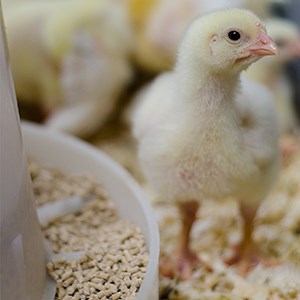Fakta:
This project is ongoing and is expected to continue until 2020. This project is funded by the Swedish research council Formas.

This project aims to develop a virtual system of maternal care using video and audio signals to improve the naturalness of rearing conditions of newly hatched chicks and promote natural behaviours, behavioural synchronisation, reducing fearfulness and feather pecking in laying hens.
In Sweden, every year approximately 7 million chickens (Gallus gallus domesticus) are incubated, hatched and reared in commercial conditions without a mother to help them navigate their new environment and facilitate finding food, water and establish a daily behavioural rhythm (behavioural synchronisation). Birds reared under these conditions, without maternal care, still manage to find food and water since they are a precocial species, but ensuring all birds find these resources soon after hatching is still a concern. In addition, birds reared without a broody hen are more fearful and perform more severe feather pecking as adults than birds reared with a broody hen. While there are clear welfare advantages of rearing chicks with broody hens, keeping young and adult birds together in a commercial scale would be very difficult due to bio-security and logistical reasons. Nevertheless, there is evidence that artificially recreating some aspects of avian maternal care under commercial situations can lead to great welfare improvements. Such an example is the use of dark brooders to simulate the dark and warm environment that a broody hen provides to the chicks. The use of dark brooders during rearing has been shown to reduce fearfulness and severe feather pecking in adult birds.
There are other aspects of maternal care (other than dark-warmth) that could be reproduced to simulate maternal care and that may have positive implications for the birds' welfare. For example, hens communicate with the chicks mainly by using a combination of behavioural displays and vocalizations to attract birds to key resources, help them find food, direct their pecking behaviour to desirable substrates and to synchronise their behaviours. Part of the natural repertoire of behaviours of the young chicks is to follow and imitate their mother's behaviour. It has been shown that poultry can learn to perform certain behaviours simply by observing other bird performing it on a video screen. For example, videos of conspecifics can be used to induce socially facilitated feeding behaviour and dust bathing in chickens. Similarly, hens can respond to sound recordings with appropriate behavioural responses specific to the type of call. However, the potential applications of virtual reproduction of visual and auditory aspects of maternal care, to induce social facilitation of desirable behaviours and synchronisation of their daily patterns, remain largely unexplored.
For these reasons, the present project aims at developing a virtual system of maternal care using video and audio signals to improve the naturalness of rearing conditions of newly hatched chicks and promote natural behaviours, behavioural synchronisation, reducing fearfulness and feather pecking in laying hens.
Carlos Hernandez, carlos.hernandez@slu.se
Anette Wichman, Jenny Yngvesson, Harry Blokhuis and Linda Keeling (Department of Animal Environment and Health, Animal Welfare Unit)
Linnéa Christenson
This project is ongoing and is expected to continue until 2020. This project is funded by the Swedish research council Formas.